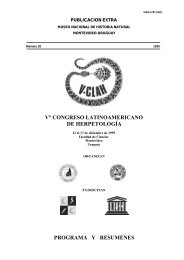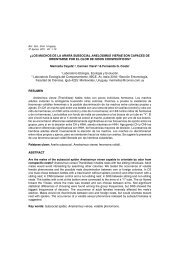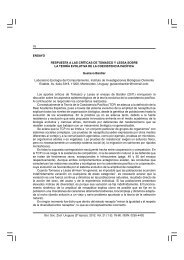Primer Congreso Uruguayo de Zoología - Sociedad Zoológica del ...
Primer Congreso Uruguayo de Zoología - Sociedad Zoológica del ...
Primer Congreso Uruguayo de Zoología - Sociedad Zoológica del ...
Create successful ePaper yourself
Turn your PDF publications into a flip-book with our unique Google optimized e-Paper software.
THE USE OF SELECTED FISH SPECIES FOR WATER QUALITY MONITORING BIOASSAYS,WITH SPECIAL REFERENCE TO THE ZEBRAFISH EMBRYO TOXICITY ASSAY (ZETA)Rodríguez-Ithurral<strong>de</strong>, D.Laboratorio <strong>de</strong> Neurociencia Molecular y Toxicología <strong>de</strong>l Desarrollo, Instituto <strong>de</strong> Investigaciones Biológicas Clemente Estable (IIBCE). Av.Italia 3318. drit@iibce.edu.uyProtection of aquatic ecosystems and drinking water supplies is one of the great environmental challenges facing usand future generations. Growing tensions between use and protection of water resources has led to the rapid<strong>de</strong>velopment of innovative methods for water quality assessment and chemical toxicity <strong>de</strong>termination, e.g., fishbioassays, which are cheaper and exhibit higher throughput than tests using mammals. International environmentalagencies standardized studies in three main species, zebrafish (Danio rerio), medaka (Oryzias latipes) and fatheadminnow (Pimephales promelas), whereas trout (Oncorynchus mykiss) is used for <strong>de</strong>tecting endocrine disruptingchemicals. Our zebrafish embryo toxicity assay (ZETA) follows protocols validated by the German Fe<strong>de</strong>ralEnvironment Agency (GFEA) and uses embryos that we produce following international regulations. In ZETAmultiparametric bioassay, embryos from 0.5 to 96 hours post-fecundation (hpf) were incubated at 28ºC –one perwell- in ELISA plates un<strong>de</strong>r a 14/10 light-darkness cycle, in the presence of water or drug un<strong>de</strong>r study. As hundreds ofassays can be run simultaneously, many samples per exposure condition (e.g., geographic point) are possible. At fixedperiods of <strong>de</strong>velopment, a number of globally accepted end-points were <strong>de</strong>termined, following GFEA protocols.Involvement of the following body systems/functions was assessed: ecclosion events, cardiac structure andfrequency, nervous system and sense organs <strong>de</strong>velopment, and vascular, pericardic, digestivo-viteline ormusculoskeletal malformations. Our method allowed us to unveil a number of teratogenic and toxic actions ofglyphosate-based herbici<strong>de</strong>s which are presented in a separate report. We envisage an immediate application of ourZETA assay to assess water quality of relevant Uruguayan hydrological bodies.EVALUACIÓN DE LA CALIDAD DEL AGUA EN LA CUENCA LECHERA DE PASO SEVERINOMEDIANTE INDICADORES BIOLÓGICOSSilva, M. 1,2 ; J. P. Pacheco 1 ; P. García 1 ; V. Olivero 3 ; M. Gonzalez; D. Fabián; G. Chalar & R. Arocena1 Sección Limnología. Facultad <strong>de</strong> Ciencias. 2 LATU. Unidad Fray Bentos. 3 Proyecto Florida SustentableLa contaminación <strong>de</strong> ríos ocasiona la pérdida <strong>de</strong> valor <strong>de</strong> estos ecosistemas como reserva <strong>de</strong> biodiversidad y recursonatural, fuente <strong>de</strong> agua potable, riego o recreación. La lechería es <strong>de</strong> las activida<strong>de</strong>s agropecuarias máscontaminantes, aportando materia orgánica y nutrientes, que aumentan la turbi<strong>de</strong>z, <strong>de</strong>manda <strong>de</strong> oxígeno y losorganismos patógenos. Es importante realizar estudios <strong>de</strong> la calidad <strong>de</strong>l agua que permitan evaluar el estado <strong>de</strong> losecosistemas acuáticos y el impacto <strong>de</strong> las activida<strong>de</strong>s productivas, integrando tanto el análisis <strong>de</strong> los parámetrosfísico-químicos como biológicos, que nos permitan evi<strong>de</strong>nciar la calidad ecológica <strong>de</strong> estos ecosistemas. Asimismo, elconocimiento <strong>de</strong> las activida<strong>de</strong>s productivas en la cuenca nos permite estimar la proce<strong>de</strong>ncia y magnitud <strong>de</strong> losimpactos a los cuales están sometidos los ecosistemas.Uruguay ha experimentado un fuerte <strong>de</strong>sarrollo <strong>de</strong> la actividadlechera en los últimos tiempos, particularmente en la cuenca <strong>de</strong> Paso Severino, Florida. Este embalse es unaimportante reserva <strong>de</strong> agua potable para la zona metropolitana. Los objetivos <strong>de</strong> este trabajo son evaluar la calida<strong>de</strong>cológica <strong>de</strong> arroyos <strong>de</strong> la cuenca lechera <strong>de</strong> Paso Severino mediante el análisis <strong>de</strong> las características físico-químicas<strong>de</strong>l agua, <strong>de</strong> los usos <strong>de</strong> cuenca y <strong>de</strong> la comunidad <strong>de</strong> macroinvertebrados acuáticos.<strong>Primer</strong> <strong>Congreso</strong> <strong>Uruguayo</strong> <strong>de</strong> <strong>Zoología</strong> 53







